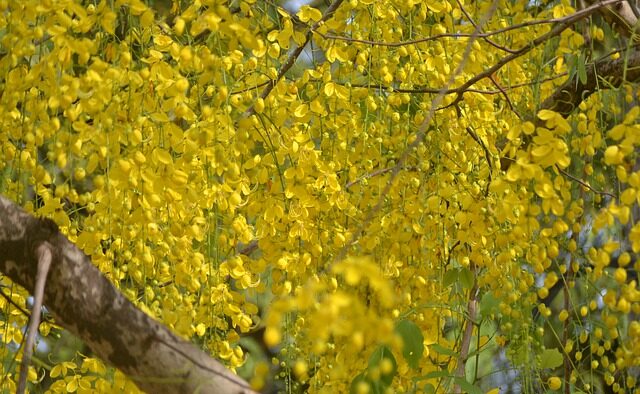Āragvadha (Cassia fistula), is a very popular plant growing both in the wilderness and chosen for gardens in India, due to its natural beauty but also with its importance for treatments. Commonly known as amalataas, it is one of the most beautiful of all tropical trees. Medical texts such as the Charaka Samhita from the 2nd century BCE include two separate chapters on āragvadha, one in the general concepts of Sutrasthana and one in the preparation section called Kalpasthana. Charaka mentions āragvadha as one of the useful and popular drugs for external application on the human body for specific disease conditions of fever, heart disorders, pain, skin diseases, and or lower abdominal pain, with preparations detailed in Charaka Kalpasthana chapter 8.
 For various treatment purposes, different parts of the plant are harvested and made in specific ways into medicinal formulations. The green leaves, the dried leaves, the bark of the plant, the pulp of the long pod-like fruits are used. The fruits are dark-brown cylindrical pods, up to two feet long, which contain the flattish brown seeds, up to 100 in one pod. The bright yellow flowers, which are the state flowers of Kerala, also have the same quality but are excellent for cleaning the blood, known as raktasodhana. Its actions as an ayurvedic drug are due to its guru (heavy-to-digest), madhura (sweet), and sheeta (cooling) properties.
For various treatment purposes, different parts of the plant are harvested and made in specific ways into medicinal formulations. The green leaves, the dried leaves, the bark of the plant, the pulp of the long pod-like fruits are used. The fruits are dark-brown cylindrical pods, up to two feet long, which contain the flattish brown seeds, up to 100 in one pod. The bright yellow flowers, which are the state flowers of Kerala, also have the same quality but are excellent for cleaning the blood, known as raktasodhana. Its actions as an ayurvedic drug are due to its guru (heavy-to-digest), madhura (sweet), and sheeta (cooling) properties.
आरग्वधो गुरुः स्वादुः शीतलः स्रंसनोत्तमः |
ज्वरहृद्रोगपित्तास्रवातोदावर्तशूलनुत् ||१३२||
तत्फलं स्रंसनं रुच्यं कुष्ठपित्तकफापहम् |
ज्वरे तु सततं पथ्यं कोष्ठशुद्धिकरं परम् ||१३३||
Source: Charaka Samhita, sthana, chapter, sloka 132-133
Transliteration -
āragvadhō guruḥ svāduḥ śītalaḥ sraṁsanōttamaḥ |
jvarahr̥drōgapittāsravātōdāvartaśūlanut ||132||
tatphalaṁ sraṁsanaṁ rucyaṁ kuṣṭhapittakaphāpaham |
jvarē tu satataṁ pathyaṁ kōṣṭhaśuddhikaraṁ param ||133||
Translation - Āragvadha having guru guna, svadu (mild sweet), sitala (cooling) properties, is most well-known for its effectiveness as a purgative. Its also cures jwara, cardiac disorders, pittaja roga, udavarta (flatulence), and relieves sula (pain). The fruit pulp is used for virechana (therapeutic purgation), ruchikara, cures skin disorders, and kaphaja roga.
 In addition to all these uses however, the most famous use of āragvadha is for a specific type of constipation called sramsana, for which it is the prototype drug. It refers to undigested food stuck to the sides of the colon due to dry sticky nature, preventing the colon from pushing the contents forward, thus resulting in constipation. This is common today with people who restrict fats and oils in their meals to the point where everything is dry.
In addition to all these uses however, the most famous use of āragvadha is for a specific type of constipation called sramsana, for which it is the prototype drug. It refers to undigested food stuck to the sides of the colon due to dry sticky nature, preventing the colon from pushing the contents forward, thus resulting in constipation. This is common today with people who restrict fats and oils in their meals to the point where everything is dry.
When families could not find a physician to give them the medicinal process of purgation, they would use an over-the-counter dilute equivalent of the medicinal formulation by making a food that would relieve chronic constipation, known as āragvadha dosa or pancake.
The Āragvadha Pancake
Ingredients
fresh āragvadha flower - 100gm
wheat flour - 150gm
black pepper - 2gm, about half teaspoon
saindava lavana - 4gm, just less than a teaspoon
clean water - as needed
til tel (sesame oil) - as needed
Preparation
From a friendly āragvadha tree, take permission to collect 20-25 fresh flowers. Carefully remove any green parts and any dust or particles from the flowers. Cut the flowers into very small pieces.
Place 150 grams of finely-milled wheat flour into an earthen pot. Add 100 grams of flowers, then black pepper and saindhava lavana and mix the dry ingredients fully and thoroughly. Then add sufficient water to make it semi-liquid like thick pancake batter or dosa batter. Set aside.
Heat a frying pan and add enough sesame oil to coat the bottom. When the oil becomes frothless, it is ready to act medicinally to remove ama dosa. One by one, make small cakes from the semi solid paste of batter and place it in the oil. Let both sides fry properly. Serve immediately while it is mildly hot.
Eating this pancake should result in a comfortable large bowel movement the next morning.





